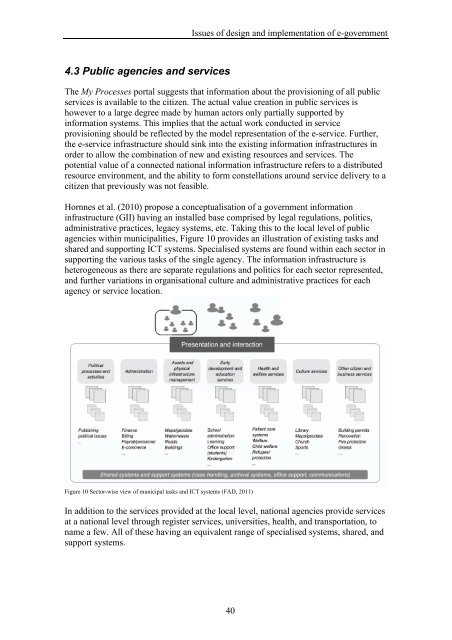Multi-channel provisioning of public services - Department of ...
Multi-channel provisioning of public services - Department of ...
Multi-channel provisioning of public services - Department of ...
Create successful ePaper yourself
Turn your PDF publications into a flip-book with our unique Google optimized e-Paper software.
Issues <strong>of</strong> design and implementation <strong>of</strong> e-government<br />
4.3 Public agencies and <strong>services</strong><br />
The My Processes portal suggests that information about the <strong>provisioning</strong> <strong>of</strong> all <strong>public</strong><br />
<strong>services</strong> is available to the citizen. The actual value creation in <strong>public</strong> <strong>services</strong> is<br />
however to a large degree made by human actors only partially supported by<br />
information systems. This implies that the actual work conducted in service<br />
<strong>provisioning</strong> should be reflected by the model representation <strong>of</strong> the e-service. Further,<br />
the e-service infrastructure should sink into the existing information infrastructures in<br />
order to allow the combination <strong>of</strong> new and existing resources and <strong>services</strong>. The<br />
potential value <strong>of</strong> a connected national information infrastructure refers to a distributed<br />
resource environment, and the ability to form constellations around service delivery to a<br />
citizen that previously was not feasible.<br />
Hornnes et al. (2010) propose a conceptualisation <strong>of</strong> a government information<br />
infrastructure (GII) having an installed base comprised by legal regulations, politics,<br />
administrative practices, legacy systems, etc. Taking this to the local level <strong>of</strong> <strong>public</strong><br />
agencies within municipalities, Figure 10 provides an illustration <strong>of</strong> existing tasks and<br />
shared and supporting ICT systems. Specialised systems are found within each sector in<br />
supporting the various tasks <strong>of</strong> the single agency. The information infrastructure is<br />
heterogeneous as there are separate regulations and politics for each sector represented,<br />
and further variations in organisational culture and administrative practices for each<br />
agency or service location.<br />
Figure 10 Sector-wise view <strong>of</strong> municipal tasks and ICT systems (FAD, 2011)<br />
In addition to the <strong>services</strong> provided at the local level, national agencies provide <strong>services</strong><br />
at a national level through register <strong>services</strong>, universities, health, and transportation, to<br />
name a few. All <strong>of</strong> these having an equivalent range <strong>of</strong> specialised systems, shared, and<br />
support systems.<br />
40
















